Brave Little Company Theatre Presents Bravo, Chico Canta! Bravo!
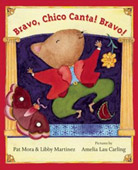 Through December, the Brave Little Company of Houston is performing a play based on Bravo, Chico Canta! Bravo!, written by Pat and her daughter Libby Martinez. Schools, libraries, hospitals, and community centers can book the show through Young Audiences of Houston.
Through December, the Brave Little Company of Houston is performing a play based on Bravo, Chico Canta! Bravo!, written by Pat and her daughter Libby Martinez. Schools, libraries, hospitals, and community centers can book the show through Young Audiences of Houston.
We sent Brave Little Theatre some questions about this play and about their previous production of Pat’s book Tomás and the Library Lady.
How and when did your touring company start?
We started in 2013, with our first production, Pat’s Tomás and the Library Lady, adapted by the very well-known playwright José Cruz González. We have some wonderful theaters who produce plays for children and families in Houston, but I thought there was an opportunity for a group that wanted to do new and original works, staged in an imaginative way, for diverse audiences and artists.
All of our productions tour to schools, libraries, hospitals, and community centers, through Young Audiences of Houston. Everything fits in a small hatchback–we use a lot of collapsible set pieces and fabric. Umbrellas are our favorite props! In addition to productions, we also conduct residencies and workshops in theater and playwriting.
How do you select which books to perform?
Sometimes our plays are based on books, and sometimes they are original works. When we look for a new piece to work on, we look for
- Stories which have a kid as the main character, but which feature multiple generations of a family. It’s important that both kids and their grown-ups feel engaged in a production, and one way to do that is to have parents and kids depicted onstage together. In Tomás and the Library Lady, we meet Tomás’ mother and father, as well as his Papa Grande (grandfather), and the Library Lady becomes sort of an adopted family member. In Bravo, Chico Canta! Bravo! we meet Mr. and Mrs. Canta, as well as Chico’s 11 brothers and sisters.
- Using found objects to create theater the way kids play. In a kid’s imagination, a couple of handheld fans can transform into a moth, an umbrella frame can become a spider, and a soda bottle can become a cricket. That’s what they do in Bravo, Chico Canta! Bravo! We want the audience’s imagination to play an active role in creating the world of the play. This practice actually came about because our set and props designer, Jodi Bobrovsky, conceptualized our production of Tomás and the Library Lady as only including props that Tomás and his family might have had in their car as they drove from Texas to Iowa to find work.
- Reflecting the diversity of Houston’s audiences and artists. When I was a kid going to see plays, I always looked for characters who reminded me of myself. I think most kids do that. Houston is a very diverse place, and we had an opportunity to depict that diversity onstage. That’s why we call ourselves “Theatre for Everyone.”
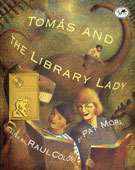 Why did you choose Tomás and the Library Lady?
Why did you choose Tomás and the Library Lady?
I fell in love with the script. The boy Tomás seemed like a real person, and I thought many students in Houston, who are learning English as a second, third, or fourth language, would relate to Tomás’s finding out how language can make his big imagination real.
Our production had two actors who played multiple roles. We knew the show had previously been produced using lots of projections, but that would not really work for our performance spaces. So I also cast a puppeteer.
In this production, the chickens at the migrant worker camp were actually feather dusters. The moon that howls like a dog in Tomás’s imagination was represented by a large white umbrella. Papa Grande was played by a dust mop (in reference to his large mustache).
That was a good start for a brand new theater!
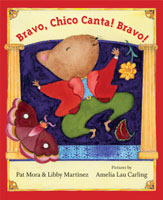 Why did you choose Bravo, Chico Canta! Bravo!?
Why did you choose Bravo, Chico Canta! Bravo!?
A friend of the company who works at Houston Public Library recommended that we consider adapting another of Pat Mora’s works to go along with the 20th anniversary of Día de los Niños/Día de los Libros. When I read Bravo, Chico Canta! Bravo! I knew it was the piece for us. In addition to all the ideas we usually look for, I liked that it took place inside an old theater, and that the Canta family put on their own plays. When students see our plays, I always want them to think about how much fun that would be to do at home.
In Houston, there are many kids who speak English plus another language – usually Spanish, but also Mandarin, Arabic, Vietnamese, and many others. I thought they would find something unique in a fully bilingual show, no matter what language they speak at home.
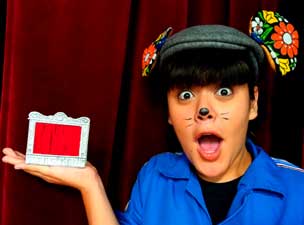
Jazmine Blas as Chico Canta. Photo by Troy Scheid.
I don’t speak Spanish, but I am bilingual (in German!). Both of the actors in the show, Jazmine Blas and Crystal Mata, are bilingual in Spanish (and Jazmine speaks French too). When we were creating the adaptation, we all worked together to try out different ideas to see how they worked in both languages.
In our play, Chico and Mrs. Canta end up writing a play about how they got rid of the problem of Gato-Gatito once and for all–just the way Pat Mora and her daughter Libby Martinez wrote the book together.
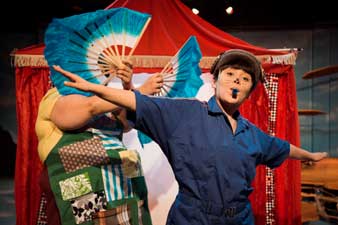
Moths! ¡Polillas!
L-R Crystal Mata with a moth puppet and Jazmine Blas as Chico Canta.
Photo by Ricornel Productions.
I also liked the potential for the book to become very interactive. Each audience member receives an invitation to come see the Canta family’s play–and lets them know whether they will be playing a Cricket, a Spider, or a Moth! When kids enter the cafeteria or library to see the play, they go through a “mouse door” made of a series of hula hoops. They also have to help Chico with various tasks, such as barking to scare off Gato-Gatito. Those things help the boring old school cafeteria, which the students see every day, transform into another place!
Thank you for taking the time to learn more about Brave Little Company and our plays!
Comments
Brave Little Company Theatre Presents Bravo, Chico Canta! Bravo! — No Comments
HTML tags allowed in your comment: <a href="" title=""> <abbr title=""> <acronym title=""> <b> <blockquote cite=""> <cite> <code> <del datetime=""> <em> <i> <q cite=""> <s> <strike> <strong>